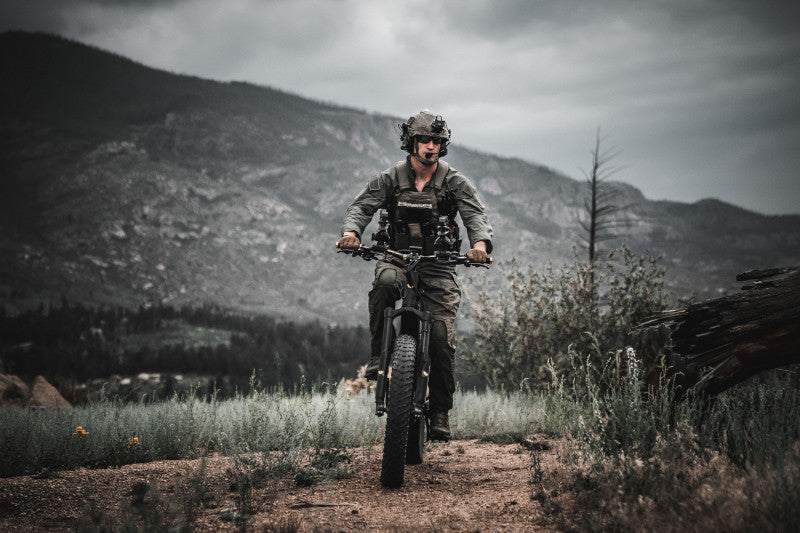Our world is still reckoning with the introduction of e-bikes. As with any brand-new, rapidly-changing technology, when the world first met e-bikes, we were essentially living in the wild west when it came to regulation, etiquette, and local, even national sentiment. Slowly, organized groups and lobbyists came out strongly opinionated on one side of the access argument or the other:
- Yes, e-bikes should be allowed access to all trails on which it’s legally permissible to ride a traditional mountain bike.
- No, e-bikes should not be treated like a traditional mountain bike and access should be more heavily regulated and restricted.
No matter which side of the coin you find yourself on, you’re likely standing shoulder to shoulder with impassioned individuals: in our experience, discussions can be heated. But as e-bikes become more common, the classifications become more clearly defined, and the benefits of e-bikes continue to be investigated and better understood, we’re making great strides in showing the world just how great an electric mountain bike can be. Not just for some but for all.
The Forest Service Makes a Big Step Towards EBike Access
A recent Forest Service’s announcement is paving the way to allowing local authoritative bodies to decide where and how e-bikes can be used on trails owned and managed by the U.S. Forest Service.
The short story: this is awesome news.
The announcement, made on September 24, says: “To promote designation of NFS roads, NFS trails, and areas on NFS lands for e-bike use, the proposed revisions include new definitions for an e-bike and a Class 1, Class 2, and Class 3 e-bike, as well as guidance and criteria for designating e-bike use on NFS roads, on NFS trails, and in areas on NFS lands.”
Currently, the National Forest Service is welcoming comments from the public on this proposed legislation. The comment period closes on October 26, 2020. After which, a final decision will be made on whether or not to move forward with implementing an updated classification system and how they correspond to e-bike access.
At this time—as we’re sure you’re well aware—e-bikes are allowed on about 40% of Forest Service roads, trails, “and in areas on NFS lands that are not designated for motor vehicle use.”
So, this is an incredible step in the right direction. We’re very excited.
The Three EBike Classifications.
Part of what this legislation does is further define the three classifications of e-bikes. Sharpening the language around this helps provide more uniform understanding and opens the door for better cohesion on e-bike legislation across the country. In short, e-bikes are classified as follows:
Class 1: Pedal-assist only, no throttle, max assisted speed is 20 mph.
Class 2: Max speed is 20 mph, but are throttle-assisted.
Class 3: Pedal-assist only, no throttle, max assisted speed is 28 mph.
Note that it’s understood that all classes limit the motor’s power to 1 horsepower.
How This Legislation Compares to the NPS and BLM
The National Park Service and Bureau of Land Management are both part of the Department of the Interior as opposed to the National Forest Service which is part of the Department of Agriculture. The Department of the Interior has historically proven to be slightly more progressive with their legislation than its counterpart when it comes to electric mountain bikes. On August 29, 2019, the Secretary of the Interior signed an executive order requiring that all NPS and BLM land allow e-bikes access to all places where other types of bicycles are allowed.
The newly-granted e-bike access—in our opinion, one that we share with many others—is nothing but great and long overdue.
How States Reckon with EBike Access
Today, across the country, when it comes to state and local-owned/managed streets and bike paths, there’s a supremely broad array of regulations and philosophies about electric mountain bikes. Without clear guidance, states have adopted outdated rules and defaulted to borrowing and retrofitting legislation frameworks over the e-bike debate. This leaves some states treating e-bikes like human-powered bicycles, some like motor vehicles, and some as something different altogether. Additionally, there are some states that have yet to even establish e-bike regulation.
We recommend looking into the particular regulations that your state and other local governing bodies have established—if not just to be informed, but also because we think it’s quite interesting.
Why Better EBike Access is Important
In our opinion, there are innumerable reasons why it’s important to allow better e-bike access in less-traveled places. But none, to us, is more important than believing wholeheartedly that experiencing America’s wild places shouldn’t be relegated to able-bodied people.
The legislation from the National Forest Service asserts, “Ebikes expand recreational opportunities for many people, particularly the elderly and disabled, enabling them to enjoy the outdoors and associated health benefits.” We couldn’t agree more and are proud to live in a country that understands the importance of access for all.



 USA
USA Canada
Canada




